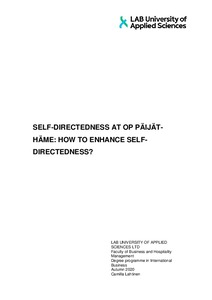Self-directedness at OP Päijät-Häme: how to enhance self-directedness?
Lahtinen, Camilla (2020)
Lahtinen, Camilla
2020
All rights reserved. This publication is copyrighted. You may download, display and print it for Your own personal use. Commercial use is prohibited.
Julkaisun pysyvä osoite on
https://urn.fi/URN:NBN:fi:amk-2020120726589
https://urn.fi/URN:NBN:fi:amk-2020120726589
Tiivistelmä
The purpose of the thesis is to provide information on how self-directedness can be enhanced in OP Päijät-Häme. Self-directedness and self-directed organizations have been discussed a lot during the recent years, and many companies aim to find better solutions for their current organizational structures. The research aimed to study self-directedness and provide valuable information to use as a case company's development plan.
In this thesis, both qualitative and quantitative research approaches are used, and the thesis is done using deductive reasoning. This survey's primary data was gathered via a quantitative survey and a qualitative e-mail survey sent to the case company's staff. Secondary data was collected from books, articles, journals, and the case company's web site.
This thesis presents theories to explain self-directedness. The definition of self-directedness is explained, and the self-determination theory is offered to create a more profound knowledge of the topic. Alongside the definition of self-directedness, the concept of the hierarchal organization structure is discussed to support the study and to understand the change that organizations go through when changing organizational structures. This thesis aims to gather information for the case company on how self-directedness is experienced and how to enhance it. In addition, it is essential to create suggestions for to case company, and the concept of TEAL organization is presented to support the recommendations.
The results of the study showed that self-directedness is discussed, but the implementation seems complicated. The development plan was created based on the results.
In this thesis, both qualitative and quantitative research approaches are used, and the thesis is done using deductive reasoning. This survey's primary data was gathered via a quantitative survey and a qualitative e-mail survey sent to the case company's staff. Secondary data was collected from books, articles, journals, and the case company's web site.
This thesis presents theories to explain self-directedness. The definition of self-directedness is explained, and the self-determination theory is offered to create a more profound knowledge of the topic. Alongside the definition of self-directedness, the concept of the hierarchal organization structure is discussed to support the study and to understand the change that organizations go through when changing organizational structures. This thesis aims to gather information for the case company on how self-directedness is experienced and how to enhance it. In addition, it is essential to create suggestions for to case company, and the concept of TEAL organization is presented to support the recommendations.
The results of the study showed that self-directedness is discussed, but the implementation seems complicated. The development plan was created based on the results.
